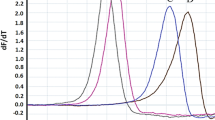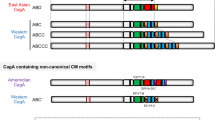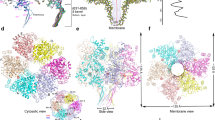Abstract
The CagA protein of Helicobacter pylori interacts with numerous cellular factors and is associated with increased virulence and risk of gastric carcinoma. We present here the cocrystal structure of a subdomain of CagA with the human kinase PAR1b/MARK2, revealing that a CagA peptide mimics substrates of this kinase family, resembling eukaryotic protein kinase inhibitors. Mutagenesis of conserved residues central to this interaction renders CagA inactive as an inhibitor of MARK2.
This is a preview of subscription content, access via your institution
Access options
Subscribe to this journal
Receive 12 print issues and online access
$189.00 per year
only $15.75 per issue
Buy this article
- Purchase on Springer Link
- Instant access to full article PDF
Prices may be subject to local taxes which are calculated during checkout



Similar content being viewed by others
References
Peek, R.M. Jr. & Blaser, M.J. Nat. Rev. Cancer 2, 28–37 (2002).
Censini, S., Stein, M. & Covacci, A. Curr. Opin. Microbiol. 4, 41–46 (2001).
Asahi, M. et al. J. Exp. Med. 191, 593–602 (2000).
Backert, S. et al. Cell. Microbiol. 2, 155–164 (2000).
Odenbreit, S. et al. Science 287, 1497–1500 (2000).
Stein, M., Rappuoli, R. & Covacci, A. Proc. Natl. Acad. Sci. USA 97, 1263–1268 (2000).
Covacci, A. et al. Proc. Natl. Acad. Sci. USA 90, 5791–5795 (1993).
Tummuru, M.K., Cover, T.L. & Blaser, M.J. Infect. Immun. 61, 1799–1809 (1993).
Saadat, I. et al. Nature 447, 330–333 (2007).
Zeaiter, Z. et al. Cell. Microbiol. 10, 781–794 (2008).
Higashi, H. et al. Science 295, 683–686 (2002).
Panneerselvam, S., Marx, A., Mandelkow, E.M. & Mandelkow, E. Structure 14, 173–183 (2006).
Huse, M. & Kuriyan, J. Cell 109, 275–282 (2002).
Russo, A.A., Jeffrey, P.D. & Pavletich, N.P. Nat. Struct. Biol. 3, 696–700 (1996).
Zheng, J. et al. Acta Crystallogr. D Biol. Crystallogr. 49, 362–365 (1993).
Knighton, D.R. et al. Science 253, 414–420 (1991).
Lu, H.S. et al. Cancer Sci. 99, 2004–2011 (2008).
Acknowledgements
We thank D. Oren and W. Shi for access to and assistance with crystallographic equipment. This work was funded in part by National Institutes of Health grants AI052182 (to C.E.S.) and RR00862, RR022220 (to B.T.C.), and by a Canadian Institutes of Health Research operating grant (MOP-62779) to M.S. M.S. is an Alberta Heritage Foundation for Medical Research Research Scholar.
Author information
Authors and Affiliations
Contributions
D.N. performed all molecular biology, cloning, protein purification, functional assays, and crystallization; Z.T.Q. performed MS under the guidance of B.T.C.; M.C.M. collected crystallographic data along with D.N. and C.E.S. solved the structure. All authors contributed to writing the manuscript.
Corresponding author
Supplementary information
Supplementary Text and Figures
Supplementary Discussion, Supplementary Methods, Supplementary Figues 1–6 and Supplementary Tables 1–4 (PDF 1035 kb)
Rights and permissions
About this article
Cite this article
Nes̆ić, D., Miller, M., Quinkert, Z. et al. Helicobacter pylori CagA inhibits PAR1-MARK family kinases by mimicking host substrates. Nat Struct Mol Biol 17, 130–132 (2010). https://doi.org/10.1038/nsmb.1705
Received:
Accepted:
Published:
Issue Date:
DOI: https://doi.org/10.1038/nsmb.1705
This article is cited by
-
Role of MARK2 in the nervous system and cancer
Cancer Gene Therapy (2024)
-
Helicobacter pylori infection
Nature Reviews Disease Primers (2023)
-
Molecular anatomy and pathogenic actions of Helicobacter pylori CagA that underpin gastric carcinogenesis
Cellular & Molecular Immunology (2020)
-
Prevalence of human papillomavirus and Helicobacter pylori in esophageal and gastroesophageal junction cancer biopsies from a case–control study in Ethiopia
Infectious Agents and Cancer (2019)
-
MARK4 protein can explore the active-like conformations in its non-phosphorylated state
Scientific Reports (2019)



